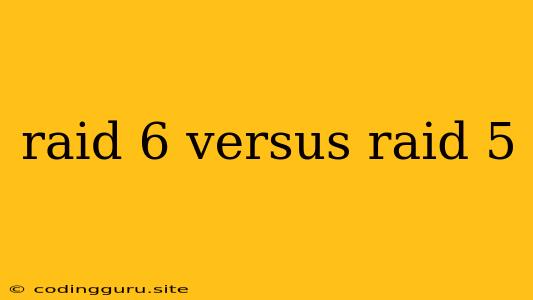RAID 6 vs. RAID 5: Which is Right for You?
When it comes to data storage, redundancy is key. Data loss can be catastrophic, especially for businesses that rely on their data for operations. This is where RAID (Redundant Array of Independent Disks) configurations come in, offering multiple levels of protection against data loss. Among the many RAID levels available, RAID 5 and RAID 6 stand out for their common use and effectiveness. But choosing between them can be a challenge, as each offers different advantages and disadvantages. This article will delve into the differences between RAID 5 and RAID 6, helping you understand which is the better choice for your specific needs.
Understanding the Basics of RAID 5 and RAID 6
Both RAID 5 and RAID 6 are advanced RAID configurations designed to provide data redundancy and improve performance. They both employ striping, which distributes data across multiple disks, increasing read and write speeds. The key difference lies in their approach to redundancy:
- RAID 5: This configuration uses one disk as a parity disk. The parity information, calculated based on the data on the other disks, is distributed across all disks. In case of a single disk failure, the lost data can be reconstructed from the parity data, allowing the system to continue operating.
- RAID 6: This configuration takes RAID 5 a step further by incorporating an additional parity disk. This provides an extra layer of protection, enabling the system to withstand two simultaneous disk failures without losing data.
Key Differences between RAID 5 and RAID 6
Here's a breakdown of the key differences between RAID 5 and RAID 6:
| Feature | RAID 5 | RAID 6 |
|---|---|---|
| Number of Parity Disks | 1 | 2 |
| Data Availability | Tolerates one disk failure | Tolerates two disk failures |
| Performance | Generally faster than RAID 6 | Slower than RAID 5 |
| Cost | Less expensive (requires fewer disks) | More expensive (requires more disks) |
| Complexity | Simpler to implement | More complex to implement |
| Data Recovery Time | Faster than RAID 6 | Slower than RAID 5 |
RAID 5: Advantages and Disadvantages
Advantages:
- Performance: RAID 5 generally offers faster performance compared to RAID 6 due to the fewer parity calculations required.
- Cost-effectiveness: It uses fewer disks, making it a more affordable option.
- Simplicity: The configuration is easier to set up and manage than RAID 6.
Disadvantages:
- Single Disk Failure Tolerance: RAID 5 can only withstand a single disk failure. Any further failures will lead to data loss.
- Higher Data Recovery Time: Rebuilding the data after a disk failure takes longer in RAID 5 compared to RAID 6.
- Increased Risk of Data Loss: The single parity disk can be a point of vulnerability, especially if the failure occurs during the rebuilding process.
RAID 6: Advantages and Disadvantages
Advantages:
- Greater Data Protection: RAID 6 offers greater data protection, allowing for two simultaneous disk failures without data loss.
- Improved Data Availability: The system can continue operating even after two disks fail, minimizing downtime.
- Reduced Risk of Data Loss: The use of two parity disks reduces the chances of data loss significantly.
Disadvantages:
- Lower Performance: RAID 6 generally performs slower than RAID 5 due to the additional parity calculations.
- Higher Cost: It requires more disks than RAID 5, increasing the overall cost.
- Increased Complexity: Implementing and managing RAID 6 is more complex than RAID 5.
Choosing the Right RAID Configuration
The best RAID configuration for you depends on your specific needs and priorities:
- High Performance & Cost Efficiency: If performance and cost are key, RAID 5 is a good choice. However, be aware of the higher risk of data loss and the increased potential for downtime.
- Maximum Data Protection & Reliability: If data integrity and availability are paramount, RAID 6 is the better option. However, be prepared for a slight performance impact and higher cost.
Tips for Optimizing RAID Performance
Regardless of the RAID level chosen, consider these tips to optimize your RAID setup's performance:
- Use High-Quality Disks: Invest in high-performance, reliable disks.
- Ensure Proper Disk Configuration: Ensure proper disk arrangement and configuration for optimal performance.
- Optimize Disk Controller Settings: Configure the disk controller for optimal performance based on your specific needs.
- Implement Regular Maintenance: Monitor the system for potential issues and perform regular maintenance to ensure optimal performance.
Conclusion
Choosing between RAID 5 and RAID 6 is a crucial decision for data storage. RAID 5 offers a good balance of performance and cost-effectiveness but sacrifices redundancy, while RAID 6 prioritizes data protection and availability at the expense of speed and cost. Ultimately, the best choice depends on your individual needs and risk tolerance. Analyze your data storage requirements, weigh the pros and cons of each configuration, and make an informed decision to ensure the security and performance of your data.
